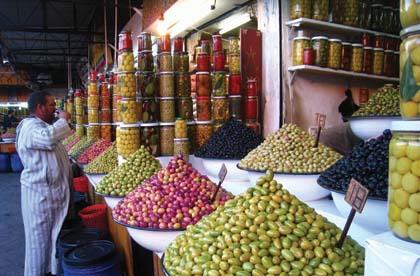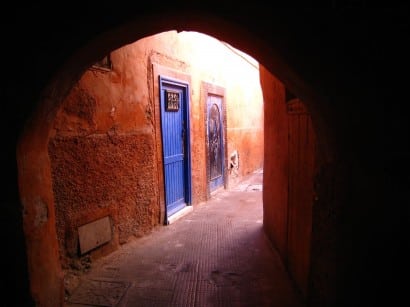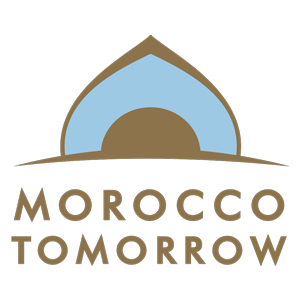When ALEX IVETT first dreamed of Morocco, see envisaged sand dunes, snake charmers and picturesque archways leading to Alice In Wonderland adventures. After her recent trip to Marrakech, she got all of that – and more.

By Alex Ivett
IF Marrakech were a person, it would be the guy that runs the spice shop on the corner. He’s loud, uncompromising and pushy, and doesn’t want to let you leave his shop without buying some spices (and a spice rack to put them in). Those I consulted before heading to theMoroccan capital had variously described it as unexpected, intense, challenging, fascinating, loud and grabby. And after spending six days there – in and around the Medina (the old fortified city) – I would agree with all these descriptions, and particularly the last. If a city can exhibit a physical gesture – then grabby would be it.
Riding the Moroccan rollercoaster
From the minute you arrive until the minute you leave, it is a fast paced, enthusiastic rollercoaster of sights and shopping. Of beautiful, tiled, quiet, walled palaces, and alleyways of yelling, action and noise. Of people selling, and tourists buying. Of men trying to get your attention, trying to keep your attention, and trying to swap you for camels. I am worth two. My travelling companion, apparently 100. I won’t quit my day job.
We arrive at 11.30pm, with the forewarned knowledge that we shouldn’t pay more than 100 dirham (about £7) for a taxi from the airport to the old city under any circumstances. However, at this time of night, and with other transport options like the 40 dirham bus not running (or so we’re told), it is difficult to argue with the quoted 200 dirham price at the taxi rank. A small win is gained in negotiating 20 dirham off, but as punishment we’re dropped at the edge of the old city, with a vague wave down a dark alley and instructions it’s a two minute walk straight ahead. To be fair, it would have been difficult to fit a wheelie suitcase down these alleyways, let alone a cab, but it’s dark, we’re lost, and all we can see is high walls and Alice In Wonderland doors.
Nothing for free here
This is where the informal human Google map system of Marrakech steps in. Look slightly flummoxed anywhere in the city’s twisting alleyways and a local boy will step up to show you the way. A couple of turns down darker, smaller alleyways later and we’re at our hostel door. I turn to offer the leftover change (about £2 – not a bad earner for 30 seconds/50 meters work) and learn my first lesson – nothing in Marrakech is for free. Or even for minimum wage. “Not good enough, I want notes,” the eight year old Moroccan Bernie Madoff demands. Blustering and apologizing as only a white privileged tourist can in a developing country – simultaneously feeling guilty but pissed off at being abused – we escape behind the hostel walls.
Equity Point Hostel is an oasis of calm. And I use the term ‘hostel’ loosely, as behind the thick black door set in a high ochre wall is a series of courtyards, around which beautifully detailed rooms (£11 – 18 per night for dorms, and £45 – 60 per room for doubles and twins) and open sitting spaces are distributed. In the final courtyard is a pool, open to the sky. This could pass for a four-star hotel, let alone a hostel. The restaurant on the top floor (breakfast included) has tables dotted around the open rooftop spaces, and you can look out over the city imagining James Bond villains jumping and running from one uneven roof to the next.

Meandering through Marrakech
Time in Marrakech is best spent wandering down the hidden alleyways of the Medina and up through the souks (marketplaces). These crowed passageways sell everything you can’t possibly fit back into your 10 kilo Ryanair carry on, ranging from the expected – leather, jewelry, lanterns, carpets, spices, colorful bowls, ‘hand-woven scarves’, to the ridiculous – Louis Vuitton covered soccer balls, crocodile skins and chameleons. As long as you don’t mind feeling like you’re in the middle of a late night shopping advert (“buy, buy, buy – this price won’t last long!!!”) then this is a fascinating, if a little touristy, area to get lost in.
For relief from the noise, the crowds and to keep your wallet full of dirham, there are a number of interesting historical sites in the old city lurking behind those high thick walls. Palace Bahia, built in the 1860s for the ‘grand vizier’ (oooh, look at me, I have a fancy title and many women…), as well as the Dar Si Said House (oooh, look at me, I am the grand vizier’s brother and I equally have much money, and my women are more beautiful because they have their own indoor pool) are both amazing, beautifully decorated warrens of rooms and courtyards and gardens. Set amongst the closely packed old city, its like walking into an Escher painting, as you wander through cool, quiet, intricately tiled, high ceilinged spaces that were unimaginable when outside in the hot crowed alleyways. At the Dar Si Said House, the guard notices me reading the (limited) English translations with amusement (a marble bath is referred to as ‘she’, with ‘garlicky decorations’) and gestures me to follow him behind a closed door. I am treated to my own private viewing of the concubine courtyard – not yet fully restored or open to the public, and all the more beautiful for its untouched crumbling tiled walls.
The Maison Tiskiwin, behind another door, in an alleyway just around the corner, is also worth a visit. Unlike the other sites, which are sparse in furnishings, this one is crowded with artifacts from the Moroccan to Mali trading route, collected and displayed by a Dutch anthropologist in his own house and accompanied by detailed English descriptions in a separate book if you’re so inclined in the 30 degree heat to learn things. Which I was not.

The square of life
However, beyond these hidden sites, and central to what Marrakech really is, is the Jemaa el Fna Square. Bordered with cafes and shops, and packed full of stalls selling freshly squeezed orange juice for 30 pence a glass, this massive square in the centre of the Medina is like a living embodiment of a ‘this is Morocco’ tourist poster you might see in the window of your local travel agent. You would start to think the nightly food markets, snake charmers, henna tattooists, musicians, story tellers and teeth pullers are all there for the tourists benefit, if it weren’t for the thousands of Moroccan’s crowding equally enthusiastically into the square. Of course, they are unlikely to be charged £4 to take a photo of the snakes, or be pulled aggressively onto a bench to eat what was, to be honest, pretty mediocre food, but the square is nonetheless an experience, and one worth having.
Get out of town
If you are like we were and faced with a few days to spare, it is worth taking a trip outside of Marrakech into the surrounding mountains and desert. Book once you’re there – prices quoted on the internet all seem to be double or triple what you’ll be charged once in Marrakech, although be prepared to be in a non-air-conditioned mini bus for long stretches of time. Nothing in Morocco is close, no matter what your guide may tell you.
The scenery outside Marrakech is not your traditionally scenic vistas – it’s too bare, dusty and rocky for that. It is however, at first, dramatic – as you climb a twisting, single road up through the rocky outcrops dotted with goats, and then interesting – as that gives way to flatter expanses. Here, square, clay, flat-roofed villages of ochre and brown blend into the lumpy hills behind. Random fields of alfalfa and green wheat sometimes break up the monochrome, and at different points we have the opportunity to wander through villages, and fields, past donkeys and hardworking, head-scarfed women tending to their crop. I always find this kind of tourism at once insightful into a different way of life, and odd – it seems intrusive to be huddled in groups staring at people as they go about their daily business. Same as if a group came and stared at me at work while I pushed some paper clips around my desk.
Don’t get the hump
Part of the ubiquitous Marrakech ‘out of town tour’ is the camel ride through the sand dunes to spend a night in a desert camp. All sounds well and good until you’ve spent an hour bumping uncomfortably around on a drooling, spitting, not-quite-a-horse like creature in the hot sun. However, watching the sunset over the yellow dunes, then spending the night under the stars, eating an impressively made (given the cooking facilities) chicken tagine, listening to our Berber guides banging out some Berber classics on goat skin drums, seems to make it all worth it. It would have, again, felt like a scene from a tourist poster if it had not been for the genuine warmth of the hosts and the natural beauty of the location.
The 10 hour bus trip back to Marrakech is broken up in its monotony only by a small boy at a rest stop coming through the group highfiving us all shyly, greeting us each with an ‘as-salam aleykum’ and a big smile. His Dad calls him away, and he backs up slowly, waving every step before giving us a final thumbs up and runs joyfully off. I can’t help but draw contrast to the similar aged boy who yelled at me in Marrakech. Marrakech is after all, exactly that – a city of contrasts. The hidden walled oasis’s of calm and space versus the hectic sweat of the alleys and square. The friendliness of many versus the aggressive rudeness of others. And of course, the obvious touristiness of it all versus the glimpses of real and unique Moroccan life. Whether it’s worth it, is up to you.
Morocco – have you been? What did you think? Tell us below:
.



